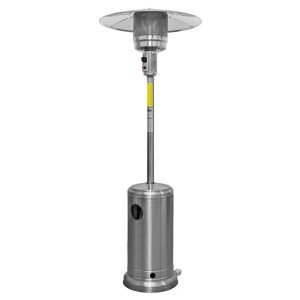The 3 Greatest Moments In Buy Outdoor Patio Heaters History
Guide to Buying Outdoor Patio Heaters: Everything You Need to Know
As the cool nights of fall and winter approach, numerous property owners and dining establishment owners watch for ways to extend their outdoor enjoyment. Outdoor patio heaters provide a comfortable and welcoming atmosphere, making them indispensable for alfresco dining, barbecues, or simply enjoying a peaceful evening outside. Fireplaces And Stoves intends to provide an extensive overview of outdoor patio heaters, consisting of the types offered, key functions to think about, suggestions for buying, and responses to often asked questions.
Types of Outdoor Patio Heaters
Patio heaters are designed in various styles and technologies to meet varied requirements. Here's an introduction of the most typical types:
Heater Type
Description
Pros
Cons
Propane Heaters
Make use of liquid propane gas for heating, typically portable with wheels for easy mobility.
Portable, high heat output.
Minimal run time; needs propane refills.
Natural Gas Heaters
Link straight to a gas line, providing consistent heat without the requirement for refills.
Convenient and cost-efficient in the long term.
Completely set up; less versatile.
Electric Heaters
Utilize electrical power to produce heat, frequently in a smooth, modern design.
Easy to use; no emissions or fumes.
Greater energy expenses; restricted heat variety.
Infrared Heaters
Use infrared innovation to directly heat objects and people instead of the surrounding air.
Efficient and instant warmth.
Minimal variety; needs electrical energy.
Tabletop Heaters
Smaller sized, portable heaters developed to rest on tables for intimate seating plans.
Space-saving; stylish options available.
Restricted heating capability compared to larger designs.
Secret Features to Consider
When selecting an outdoor patio heater, it's important to evaluate different functions to ensure you make a notified choice. Here are some crucial aspects to consider:
Heat Output: Measured in BTUs (British Thermal Units), a greater BTU score suggests more heat output. For a comfy outdoor experience, try to find heaters using between 30,000 to 50,000 BTUs.
Size and Capacity: The size of the heater must be proportionate to the space offered for heating. Consider the area size and the variety of individuals you expect to captivate.
Material: Patio heaters are generally made from stainless-steel, aluminum, or copper. Stainless steel is robust and resistant to the components, which is ideal for outdoor use.
Design: Choose a style that complements your outdoor design. There are numerous designs, including freestanding, wall-mounted, and tabletop options. Consider what fits finest in your space.
Safety Features: Look for models with security features, such as an automated shut-off switch, anti-tilt defense, and heat-resistant products. This ensures the safety of your family and visitors.
Portability: If you prepare to move your heater regularly, go with a portable model with wheels or a light-weight style.
Fuel Type: Different fuel types provide unique benefits. While propane heaters are portable, gas heaters use a more cost-effective long-lasting heating option if a connection is offered.
Purchasing Tips
To maximize your financial investment in an outdoor patio heater, think about these pointers while shopping:
Set a Budget: Determine your budget before searching. Prices differ significantly depending on size and features.
Check out Reviews: Look for customer examines online to evaluate performance and reliability.
Store Seasonally: Prices may drop throughout off-seasons, making it the ideal time to score an offer.
Buy Only When Necessary: Assess your heating needs periodically. If you hardly ever utilize the outdoor space during cooler months, prioritize quality over amount.
Consider Warranty and Support: Check for service warranty policies and customer assistance. An excellent guarantee can offer peace of mind.
Regularly Asked Questions (FAQs)
1. The length of time does a propane tank last in an outdoor heater?
The runtime of a propane tank varies depending on the BTU output of the heater. Generally, a standard 20 pound propane tank can last anywhere from 8 to 12 hours, depending on the heat setting.
2. Can I utilize an outdoor patio heater inside?
No, outdoor patio heaters are not designed for indoor use due to the risk of carbon monoxide poisoning and combustion dangers. Always utilize heaters in well-ventilated areas.
3. Do outdoor heaters work in windy conditions?
Some outdoor heaters may struggle to preserve heat in windy conditions, specifically those developed to radiate heat into the surrounding air rather than directly heating items. However, wind-resistant models do exist.
4. What upkeep does an outdoor patio heater need?
Routine maintenance consists of cleaning up the heater after use, looking for gas leakages (if relevant), ensuring all connections are safe and secure, and storing the heater throughout harsh weather.
5. Is it safe to leave an outdoor heater ignored?
No, it is not recommended to leave outdoor heaters ignored, particularly those utilizing open flame. Always turn off heaters when not in use, and guarantee kids and animals are kept at a safe range.
Outdoor patio heaters are a valuable addition to any outdoor space, allowing homeowners and businesses to enjoy the fresh air even when temperatures drop. Comprehending the various types of heaters, essential functions, and practical purchasing suggestions will empower customers to select the perfect unit that fulfills their specific needs. By considering security, maintenance, and the atmosphere you want to produce, you can enhance your outdoor living experience for several years to come.
